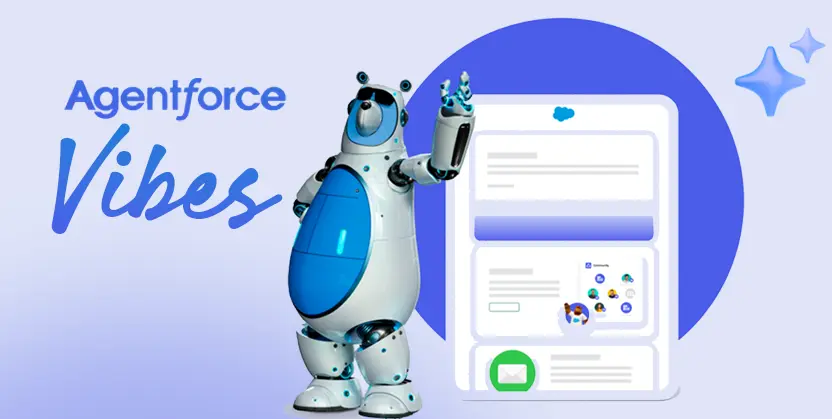Table of Contents
Development is no longer limited to writing every line of code and then reading it a million times to make sure everything is correct. As AI is taking over most of the manual work, it has also evolved the way we code with Vibe Coding.
It is a new technology that helps you in generating code and even complete development projects by simply providing AI with a detailed prompt. To make the most of this latest tech, Salesforce is jumping on the bandwagon with the launch of Agentforce Vibes. The new product, or an extension of vibe coding, lets you build apps and more using natural language prompts.
While the complete information will be revealed at Dreamforce 2025, in this blog, we explore how Salesforce Agentforce becomes a better AI with this inclusion.
What is Agentforce Vibes?
Agentforce Vibes is an AI-powered IDE extension or plug-in for Salesforce users. It enables vibe coding with natural language prompts to create or develop Salesforce components. Although vibe coding tools already exist, the differentiator here is the enterprise layer, with built-in guardrails, compliance, and governance from the Salesforce Agentforce Trust Layer.
It works alongside primary Salesforce developer tools:
- Salesforce Sandboxes for isolated testing.
- DevOps Centre, Salesforce DX, Code Analyser v5, etc.
- It integrates with VS Code–compatible editors like Code Builder, Cursor, and Windsurf.
Code With Vibe Codey: The AI Agent in Agentforce Vibes
Powering the platform from behind the scenes, Agentforce Vibe Codey is the AI agent who will be your partner in coding. Vibe Codey understands the context of your requirement, project metadata and even the structure of your org to provide you with elaborate answers. It supports Model Context Protocol (MCP) to integrate over 20 models such as Salesforce xGen and GPT-5.

Here’s a glimpse of its capabilities:
- With the context-aware Plan mode, it understands the Salesforce schema.
- It can generate code in Apex, HTML, CSS, JavaScript, etc.
- It creates multiple checkpoints while working on a project to easily roll back changes.
- It can generate test cases to run quality assurance on your code and even analyse the code for security, performance, and best practices.
- It can seamlessly integrate DevOps and deploy apps in natural language prompts.
Vibe Codey can detect and adapt to your project’s patterns and constraints. You just need to use your technical expertise to review, test, and ensure the generated code meets your standards.
How Agentforce Vibes Aligns with Salesforce Development Lifecycle & DevOps?
Agentforce Vibes isn’t standalone, as it’s built to work within the Salesforce development lifecycle, including sandboxes, DX, and DevOps practices.
- Developers can use Salesforce Sandboxes so the code generated by Vibe Codey is tested in safe, isolated environments before pushing to production.
- It plugs into DevOps Centre and ALM workflows, enabling you to manage versioning, deployment, and CI/CD pipelines.
- The governance and security frameworks provided by the Salesforce Trust Layer ensure that vibe coding stays within enterprise guardrails.
- Because it supports DX MCP, it can interoperate with external AI/agent platforms.
In short, it’s built to reduce friction: instead of jumping out of your dev flow to experiment with AI, Agentforce Vibes brings AI inside your dev tools.
Why Agentforce Vibes is Important for Developers?
While developers are already relying on AI tools to create applications and improve workflows, Agentforce Vibes will prove to be a next-gen development platform. It brings the speed and efficiency of vibe coding to Salesforce and marks the shift in how development will take place on the platform.
The importance of this extension lies in the day-to-day tasks of Salesforce developers, especially those who actively work with Agentforce. They can see an improvement in speed and gain their productivity back as Agentforce Vibes can provide faster prototypes with fewer challenges. Since Vibe Codey understands natural language, it is easier to use for newer developers who are not familiar with multiple programming languages.
Another benefit comes from the governance, compliance, and sandboxes of the Salesforce platform, as developers do not need to switch to a third-party platform, which can be unreliable. Salesforce developers only need to have knowledge of development lifecycles and be able to review the code generated by Agentforce Vibes. With gradual adoption, there is a lot more that you can uncover about the platform’s intelligence.
Agentforce Vibes & Your Skillset
Using Agentforce Vibes doesn’t replace your core developer skills; it complements them.
- When you prompt for a Lightning Web component or Apex logic, Vibe Codey can scaffold it quickly, but you’ll refine it.
- Your Salesforce DX knowledge helps you manage metadata, environments, and DevOps seamlessly with Vibes.
- Code Analyser v5, security best practices, namespacing, and governor limits still matter. AI should help here, but can’t replace the good development logic.
Over time, experienced devs will learn to prompt better and validate AI outputs faster, becoming more productive.
Summing Up
Agentforce Vibes may not be perfect today, but it signals where Salesforce development is headed. Vibe coding makes idea-to-app cycles faster, more accessible, and better connected with enterprise controls.
For developers working with Salesforce DX, Apex, LWC, and DevOps, Vibes doesn’t replace you; it enhances your toolkit. Use it to prototype fast, generate boilerplate, and let your judgment focus where it matters.
If you’re a Salesforce developer, start exploring Agentforce Vibes as soon as you can because the future might be less about writing lines and more about crafting intent.













